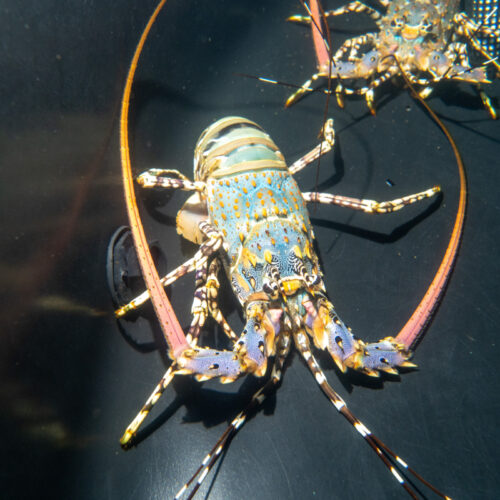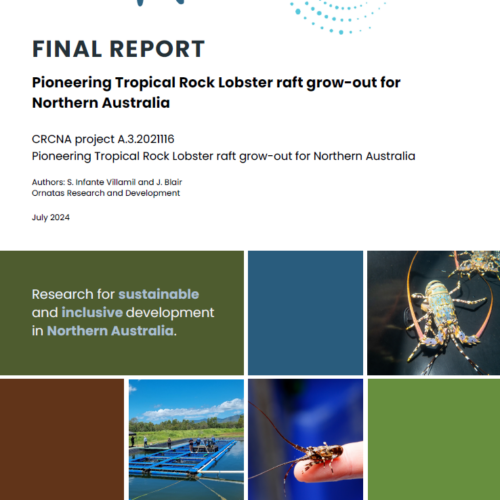
- Reference # A.3.2021116
- Project Status Current
- Timeframe 3 years (2021 - April 2024)
- Project manager Sarah Docherty
- CRCNA Funding $1,316,687
- Total project value $4,545,941
- Project research participant Ornatas ; Maxima Rock Lobster ; PFG Group ; JSJ Seafood ; Honey and Fox ; University of Tasmania
- Research Programs 3. Production and supply chain innovation in Northern Australia
- Location Broome, WA, Townsville, QLD
- Aquaculture
Summary
This project includes co-funding from the Fisheries Research and Development Corporation (FRDC).
The Australian Tropical Rock Lobster (TRL) (Panulirus ornatus) is in high demand for its superb texture and taste, and commanding a premium price (>$80/kg in some markets). However, market-size lobster supply is currently restricted to wild caught adults or lobsters on-grown in South East Asia from captured puerulus/juveniles. This places unsustainable pressure on wild TRL stocks which in turn limits the catch. Novel hatchery technology, considered a holy grail in aquaculture and developed in Australia, now makes commercial-scale production of TRL juveniles a reality to support commercialisation of full life cycle TRL aquaculture.
Sea Raft Research (Ornatas) has the Australian licence to commercialise hatchery technology needed for the establishment of support for a grow-out industry in Northern Australia. Such an industry presents significant opportunities, including diversification options for current aquaculture producers and Traditional Owner-led business development.
Ornatas has a pilot hatchery and is constructing a new juvenile production facility north of Townsville, QLD to recreate the complex oceanic environment that allows culture of spiny lobster juveniles. This project will build on this earlier work and undertake the critical science required for the next step of production, the grow-out of hatchery-produced juvenile lobsters in sea raft enclosures, with research trials in the pristine waters of northern Western Australia.
There are multiple gaps in knowledge that must be investigated to support the development and evaluation of this production technology to meet market demands. The project partners bring expertise across the production-to-market pipeline and we will focus on six research areas: environment; raft design; translocation, lobster health and biosecurity; feeding strategies; lobster growth performance; and premium diverse market acceptability. We will evaluate production systems, comparing sea raft productivity with onshore culture, to de-risk and attract quality investment in a brand-new grow-out aquaculture industry by current and new aquaculture businesses.
Expected outcomes
Within the life of the project, grow-out technology will be developed for Tropical Rock Lobsters in Northern Australia. Ornatas has a 10-year growth plan to deliver an innovative and world first $160 million p.a. industry, exporting 1,100 tonnes of Tropical Rock Lobsters from hatchery- produced juveniles, by 2030 (Ornatas’ Business Plan).
Other expected outcomes include
- Environmental monitoring and management plan developed.
- Proven design of sea raft grow-out production technology for TRL suited to Northern Australian conditions, that can be manufactured at scale.
- Documented translocation process for juvenile lobsters, including health screening protocols. Farm staff trained in the application of health screening, transport and translocation methods for routine use by Ornatas and receiving growers in NA.
- Documented performance of feeds in sea raft culture, to be used by feed developers (UTas and Ornatas) to improve the functional performance of diets for commercial-scale manufacture.
- Optimal feeding strategy, stocking density and biofouling management documented in standard operating procedures for the marine farm, developed with project technical staff and used for training new staff.
- Documented growth performance, feed efficiency, food safety and eating quality of TRL produced in sea raft grow-out systems in NA for use as a baseline to monitor system performance over time.
- Business model documented for sea raft grow-out of TRL in NA, for comparison with onshore production.
- Market monitoring system established to support farm based economic decisions around harvest and supply and to guide future market diversification and growth.
Further, this research will determine the viability of sea raft grow-out of Tropical Rock Lobsters in Northern Australia. The lobsters grown over the 3 years of the project will be used to determine market acceptability, supply chain performance, provenance authenticity technology performance and brand testing. It is anticipated that a small number of lobsters may be sold to domestic and international markets.
It is envisaged that on completion of this research the Cone Bay sea raft facility will be upscaled to produce commercial product.
Publications
15 July 2024
Pioneering Tropical Rock Lobster Raft Grow-out for Northern Australia – Final Report
Type: Report
Industry: Aquaculture


